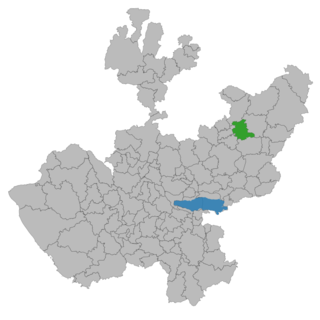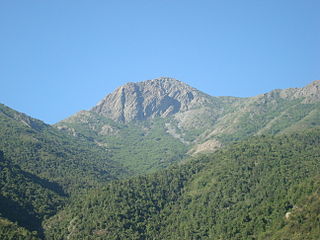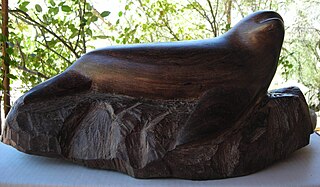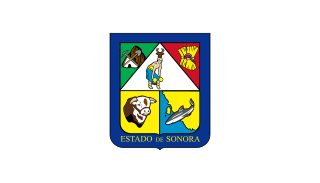
Heroica Nogales, more commonly known as Nogales, is a city and the county seat of the Municipality of Nogales. It is located on the northern border of the Mexican state of Sonora. The city is abutted on its north by the city of Nogales, Arizona, across the U.S.-Mexico border.

Puerto Peñasco is a resort town located in Puerto Peñasco Municipality in the northwest of the Mexican state of Sonora, 100 kilometres (62 mi) from the border with the U.S. state of Arizona. According to the 2015 census, it has a population of 62,177 inhabitants. It is located on the northern shores of the Sea of Cortez on the small strip of land that joins the Baja California Peninsula with the rest of Mexico. The area is part of the Altar Desert, one of the driest and hottest areas of the larger Sonoran Desert.

Navojoa is the fifth-largest city in the northern Mexican state of Sonora and is situated in the southern part of the state. The city is the administrative seat of Navojoa Municipality, located in the Mayo River Valley.

Guaymas is a city in Guaymas Municipality, in the southwest part of the state of Sonora, in northwestern Mexico. The city is 117 km south of the state capital of Hermosillo, and 242 miles from the U.S. border. The municipality is located on the Gulf of California and the western edge of the Sonoran Desert and has a hot, dry climate and 117 km of beaches. The municipality’s formal name is Guaymas de Zaragoza and the city’s formal name is the Heróica Ciudad de Guaymas.

Tiburón Island is the largest island in the Gulf of California and the largest island in Mexico, with an area of 1,201 square kilometres (464 sq mi). It was made a nature reserve in 1963 by President Adolfo López Mateos.

The Archdiocese of Hermosillo is a Roman Catholic Archdiocese located in Hermosillo, Sonora, Mexico. Its area is 90,959 sq. miles, and its population (2004) 1,067,051. The bishop resides at Hermosillo.

Telemax is a Mexican broadcast television network based in Hermosillo, Sonora. Its flagship station is XEWH-TDT in Hermosillo, and is available nationally through satellite and cable coverage. It is also available through a network of over-the-air repeaters, which extend its flagship station's coverage throughout Sonora. Telemax is owned by the State of Sonora and its stated mission is "to promote Sonoran culture and values, the works and programs of the government, and timely and truthful broadcast of information to various social segments of the population."

Jalostotitlán is a town and municipality located in the northeast corner of the state of Jalisco, Mexico, in a region known as Los Altos.
Nacozari de García is a small mining town surrounded by Nacozari de García Municipality in the northeast of the Mexican state of Sonora.

Ramón Corral Verdugo was the Vice President of Mexico under Porfirio Díaz from 1904 until their resignations in May 1911.

Cerro la Campana, the Bell mountain, is a mountain in La Campana National Park in central Chile. The Pacific and the mountain Aconcagua are visible from the summit on clear days.

Hermosillo is a municipality in Sonora in north-western Mexico. The municipal seat is the city of Hermosillo.
La Pintada is an archaeological site located some 60 kilometers south of the city of Hermosillo, Sonora, Mexico, within the “La Pintada” canyon, part of the “Sierra Libre”, a small mountain massif of the coastal plains that extends throughout the Sonoran Desert.

The Yaqui Wars, were a series of armed conflicts between New Spain, and the later Mexican Republic, against the Yaqui Indians. The period began in 1533 and lasted until 1929. The Yaqui Wars, along with the Caste War against the Maya, were the last conflicts of the centuries long Mexican Indian Wars. Over the course of nearly 400 years, the Spanish and the Mexicans repeatedly launched military campaigns into Yaqui territory which resulted in several serious battles and some infamous massacres.

Mexican ironwood carving is a Mexican tradition of carving the wood of the Olneya tesota tree, a Sonora Desert tree commonly called ironwood.
The following television stations broadcast on digital channel 28 in Mexico:

The Cerro de las Campanas is a hill and national park located in Querétaro City, Mexico. It is most noteworthy as the place where Emperor Maximilian of Habsburg and Generals Miguel Miramón and Tomás Mejía were executed, definitively ending the French intervention in Mexico. The mountain gets its name from rocks that, according to legend, make bell sounds when struck.

XHDM-FM is a radio station on 102.7 FM in Hermosillo, Sonora. It is owned by Grupo ACIR and carries its La Comadre grupera format.
3. Lagarda, Ignacio Lagarda. HISTORIA DE HERMOSILLO: Origen, Fundo Legal, Antiguos Ejidos. 2008.
4. Galaz, Fernando A. Dejaron huella en el Hermosillo de ayer y hoy : crónicas de Hermosillo de 1700 a 1967. Instituto Sonorense de Cultura, 2013.
5. Yetman, David. Sonora : an intimate geography. University of New Mexico Press, 1996.

















